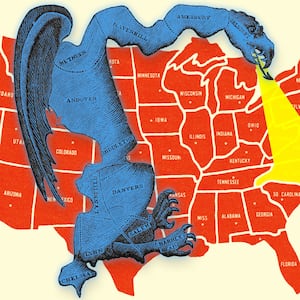When Deb Helton launched her campaign for the Ohio state legislature last year, she thought she knew what she was getting into.
A national security consultant by trade, and a Democrat by party affiliation, Helton had planned to put up a challenge to a Republican incumbent in a purple-tinged district in Summit County, where her hometown of Akron is located.
Like all states, last year Ohio began the once-a-decade process of redrawing its congressional and state legislative districts. But what has unfolded in the months since hundreds of candidates like Helton filed to run is a shambolic mess without peer in any other state.
The whiplash Helton faced—in her first campaign for office, no less—serves as something of a step-by-step guide to the chaos.
In January, the Ohio Supreme Court threw out the map that included the district Helton first decided to run in. Democrats successfully argued that the map was an unfair, partisan gerrymander in favor of Republicans that violated the state’s redistricting rules.
The next map the state’s redistricting commission produced put Helton in a different swing district, running against a different Republican incumbent, and with different Democratic primary rivals. The high court promptly threw out that map, too, also on the basis of gerrymandering.
The third map, issued in late February, put Helton in a much redder district, running against yet another Republican incumbent, and with yet another set of Democratic primary rivals. And, yet again, it was tossed by the high court, for the same reason as before.
Ohio’s redistricting commission, run by a GOP majority, is now working on a fourth set of maps, leaving blown deadlines, court challenges and a lot of very angry, frustrated people in their wake.
Left to sort through the carnage, candidates have no idea what hand they’ll be dealt next.
For Helton, it could be a Republican district or a Democratic one, a weaker or stronger Republican incumbent, or even a Democratic incumbent. If she gets the latter, Helton said she would abandon her run instead of challenging an incumbent from her own party.
“I can’t go knock on my neighbor’s door, because I’m not sure if they can get to vote for me,” Helton told The Daily Beast. “Everything is up in the air, everything is unknown.”
The chaos extends to the state’s congressional maps, too. Ohio is already on its second map there after the first was struck down as a GOP gerrymander. The second attempted map, which gives Democrats three out of 16 seats, is currently the subject of another challenge on those same grounds. The state Supreme Court could force Ohio to make a third map.
This political chaos has consequences. With Democrats already facing long odds to keep control of the U.S. House, and Ohio Democrats stuck in deep minorities in the legislature, the fate of Ohio’s tortured lines will have a real impact on the balance of power in Washington and in Columbus.
For everyone involved, there are two dates on the calendar that keep them awake at night: April 5, when early voting begins for the state’s primaries, and May 3, the primary election day itself.
That April date is already complicated. Last week, Ohio Secretary of State Frank LaRose announced there would have to be a second primary for state legislative races, because there was no way the process would be complete in time for the spring primary.
A second primary would cost the state over $20 million, scramble the campaign strategies of countless candidates and, perhaps, come at the cost of voters’ knowledge and confidence in the process.
That’s what most worries election administrators like Tonya Wichman, who runs the board of elections in Defiance County, in the state’s northwest corner.
Voters and candidates in her county want to know when the election is going to be and what, exactly, they will be voting on. She wants to provide them the answers—but with the process in the hands of a dysfunctional government in Columbus, she cannot.
“This is the 14th election I’ve run and I don’t know how to do my job right now,” Wichman told The Daily Beast. “We work hard to build voter confidence, and that’s kinda diminishing when you can't answer questions… We just want to do it right, but we need the time to do it right.”
And some Ohio politicos are pushing to delay the primary altogether—with fears that two primary election dates would complicate awareness and lower turnout.
“This is classic voter suppression tactics… They should not break up this election at all,” Nina Turner, the prominent Bernie Sanders backer who is running again for a Cleveland congressional seat, told The Daily Beast.
A bill introduced in Ohio’s Senate last week proposes pushing the entire primary back to June 28, with sponsors of the legislation hoping that would buy enough time for maps to become definitive and for elections administrators to catch up with changes.
The U.S. District Court for the Southern District of Ohio on Friday heard arguments on whether to delay the primary as a whole. But the court declined to make an immediate decision. The Ohio Supreme Court already rejected a plea from state Democrats to push the primary at large to June.
“I don’t think most Ohioans know this is even happening,” said state Sen. Tina Maharath (D), a co-sponsor of the bill.
To understand why Ohio’s process is as broken and shambolic as it is requires understanding the fraught political dynamics that produced the situation.
Just over half of the state’s voters are Republican, but the GOP controls the governor’s office and has commanding majorities in the legislature. They also have a five-to-two majority on the “independent” state redistricting commission, which has produced maps in response to court decisions.
Ohio’s courts have served as the real backstop to a Republican-dominated redistricting process. They have largely intervened to reject the GOP’s various maps because, at least at the state legislative level, they don’t meet the standards set out by reforms that voters approved, by large margins, in 2015 and 2018.
Those reforms require the state to draw fair maps for the state legislature that achieve partisan balance and keep communities together.
Republican lawmakers in Ohio actually supported those reforms. But now, they’re trying to maneuver around them. So far, the courts have not let them, denying the GOP’s state legislative maps not just once but three times.
No requirements exist for making Ohio’s congressional maps, but the disproportionate GOP bias of the first map led the state Supreme Court to strike it down. The second map maintains almost the same level of bias, so Democratic groups believe it is vulnerable to a similar fate. They are pushing for a new map even as the clock begins to tick closer to the spring primary elections.
In a statement to The Daily Beast, Ohio Democratic Party Chair Elizabeth Walters said the chaos is squarely the Ohio GOP’s fault.
“By continuing to try to push GOP-gerrymandered maps, Republicans are leaving Ohioans to foot the bill for the tens of millions of dollars it will take to fix the election chaos that the GOP has created,” Walters said.
The National Redistricting Action Fund, a wing of the Democratic group headed up by former Attorney General Eric Holder, is in court right now challenging the map. Their aim is to achieve a new, fairer map this year.
But other groups that have challenged the map, like ACLU Ohio and the League of Women voters, seem to have conceded that won’t be possible given how little time is left. They are also petitioning for a fairer map, but one that would take effect in 2024.
“We have come to a (thus far) immovable point where we are literally out of time, and we must accept the reality of the situation and the electoral calendar now before us,” ACLU Ohio said in a statement. “If the date of the primary is sufficiently delayed, we could seek relief, but unless and until that happens, we cannot.”
Each day, seemingly, brings some new kernel of information of how the landscape has shifted once again. The instability has frozen many candidates. Helton, for instance, said she is simply spending her time reading up on issues, since she has no idea who her opponent will be—or if she will even run at all.
Republicans are not immune to this, either. Many are not complaining publicly about the process, which their party is largely in charge of, that has broken down so spectacularly. But they’re also frustrated by the uncertainty.
Dan Lusheck, a spokesman for the Ohio GOP, said the party has “strong candidates, winning issues, and the resources to be successful in any political climate that may arise in 2022, especially considering Joe Biden’s historic failures.”
He added that “far-left interest groups” like Holder’s will have “zero impact on our ability to elect Republicans in key races across the state of Ohio.”
But on the district level, their candidates are facing the same challenges posed by the constant churn of maps.
When asked how to run a campaign operation when it’s unclear where, exactly, you are supposed to be campaigning, an aide to an Ohio Republican elected official had a simple response.
“Lol,” the aide texted The Daily Beast. “It’s hard.”
The aide described the limbo they, like many other campaigns, are in. Under the current maps, their boss might have thousands of new constituents. Reaching out to them requires time, effort, and campaign funds. If the maps change yet again, much of that outreach could have been a complete waste.
“It has to be the worst in the country,” the aide said of the situation.
But as the primary election creeps closer, candidates have no choice but to try to campaign with what shaky information they have. And voters are left in “constitutional chaos,” per Maharath, who suspects the next round of maps will be filled with drastic changes.
“It’s just a complete mess,” she said. “There’s no other word for it.”












